Zhouhang Xie
In-context Ranking Preference Optimization
Apr 21, 2025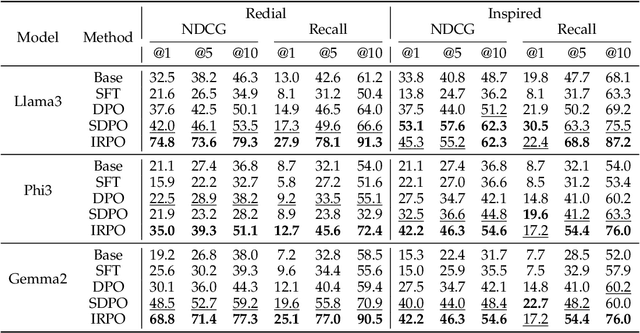
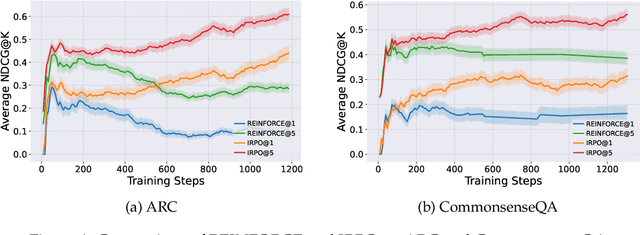
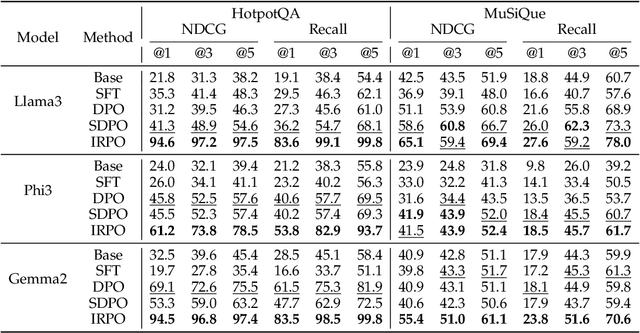
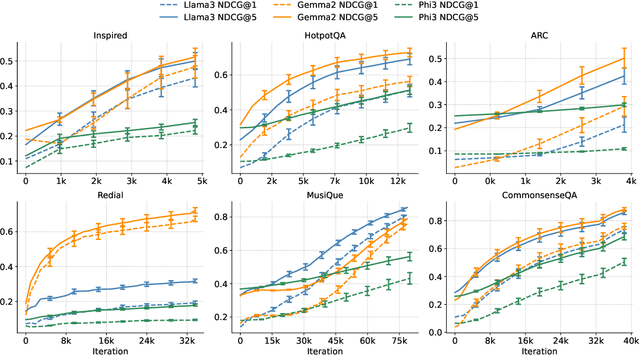
Abstract:Recent developments in Direct Preference Optimization (DPO) allow large language models (LLMs) to function as implicit ranking models by maximizing the margin between preferred and non-preferred responses. In practice, user feedback on such lists typically involves identifying a few relevant items in context rather than providing detailed pairwise comparisons for every possible item pair. Moreover, many complex information retrieval tasks, such as conversational agents and summarization systems, critically depend on ranking the highest-quality outputs at the top, emphasizing the need to support natural and flexible forms of user feedback. To address the challenge of limited and sparse pairwise feedback in the in-context setting, we propose an In-context Ranking Preference Optimization (IRPO) framework that directly optimizes LLMs based on ranking lists constructed during inference. To further capture flexible forms of feedback, IRPO extends the DPO objective by incorporating both the relevance of items and their positions in the list. Modeling these aspects jointly is non-trivial, as ranking metrics are inherently discrete and non-differentiable, making direct optimization difficult. To overcome this, IRPO introduces a differentiable objective based on positional aggregation of pairwise item preferences, enabling effective gradient-based optimization of discrete ranking metrics. We further provide theoretical insights showing that IRPO (i) automatically emphasizes items with greater disagreement between the model and the reference ranking, and (ii) links its gradient to an importance sampling estimator, yielding an unbiased estimator with reduced variance. Empirical results show IRPO outperforms standard DPO approaches in ranking performance, highlighting its effectiveness in aligning LLMs with direct in-context ranking preferences.
From Reviews to Dialogues: Active Synthesis for Zero-Shot LLM-based Conversational Recommender System
Apr 21, 2025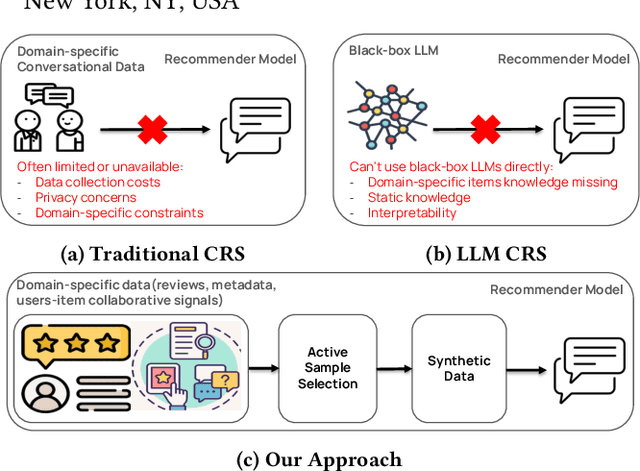
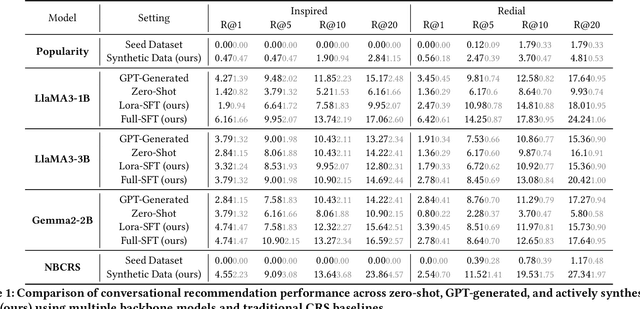

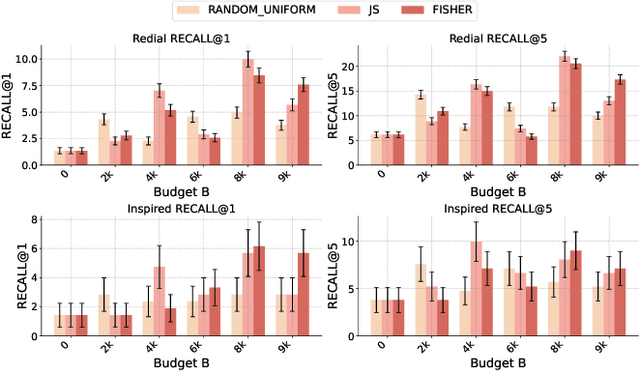
Abstract:Conversational recommender systems (CRS) typically require extensive domain-specific conversational datasets, yet high costs, privacy concerns, and data-collection challenges severely limit their availability. Although Large Language Models (LLMs) demonstrate strong zero-shot recommendation capabilities, practical applications often favor smaller, internally managed recommender models due to scalability, interpretability, and data privacy constraints, especially in sensitive or rapidly evolving domains. However, training these smaller models effectively still demands substantial domain-specific conversational data, which remains challenging to obtain. To address these limitations, we propose an active data augmentation framework that synthesizes conversational training data by leveraging black-box LLMs guided by active learning techniques. Specifically, our method utilizes publicly available non-conversational domain data, including item metadata, user reviews, and collaborative signals, as seed inputs. By employing active learning strategies to select the most informative seed samples, our approach efficiently guides LLMs to generate synthetic, semantically coherent conversational interactions tailored explicitly to the target domain. Extensive experiments validate that conversational data generated by our proposed framework significantly improves the performance of LLM-based CRS models, effectively addressing the challenges of building CRS in no- or low-resource scenarios.
Improving In-Context Learning with Reasoning Distillation
Apr 14, 2025Abstract:Language models rely on semantic priors to perform in-context learning, which leads to poor performance on tasks involving inductive reasoning. Instruction-tuning methods based on imitation learning can superficially enhance the in-context learning performance of language models, but they often fail to improve the model's understanding of the underlying rules that connect inputs and outputs in few-shot demonstrations. We propose ReDis, a reasoning distillation technique designed to improve the inductive reasoning capabilities of language models. Through a careful combination of data augmentation, filtering, supervised fine-tuning, and alignment, ReDis achieves significant performance improvements across a diverse range of tasks, including 1D-ARC, List Function, ACRE, and MiniSCAN. Experiments on three language model backbones show that ReDis outperforms equivalent few-shot prompting baselines across all tasks and even surpasses the teacher model, GPT-4o, in some cases. ReDis, based on the LLaMA-3 backbone, achieves relative improvements of 23.2%, 2.8%, and 66.6% over GPT-4o on 1D-ARC, ACRE, and MiniSCAN, respectively, within a similar hypothesis search space. The code, dataset, and model checkpoints will be made available at https://github.com/NafisSadeq/reasoning-distillation.git.
A Survey on Personalized and Pluralistic Preference Alignment in Large Language Models
Apr 09, 2025Abstract:Personalized preference alignment for large language models (LLMs), the process of tailoring LLMs to individual users' preferences, is an emerging research direction spanning the area of NLP and personalization. In this survey, we present an analysis of works on personalized alignment and modeling for LLMs. We introduce a taxonomy of preference alignment techniques, including training time, inference time, and additionally, user-modeling based methods. We provide analysis and discussion on the strengths and limitations of each group of techniques and then cover evaluation, benchmarks, as well as open problems in the field.
Latent Factor Models Meets Instructions:Goal-conditioned Latent Factor Discovery without Task Supervision
Feb 21, 2025Abstract:Instruction-following LLMs have recently allowed systems to discover hidden concepts from a collection of unstructured documents based on a natural language description of the purpose of the discovery (i.e., goal). Still, the quality of the discovered concepts remains mixed, as it depends heavily on LLM's reasoning ability and drops when the data is noisy or beyond LLM's knowledge. We present Instruct-LF, a goal-oriented latent factor discovery system that integrates LLM's instruction-following ability with statistical models to handle large, noisy datasets where LLM reasoning alone falls short. Instruct-LF uses LLMs to propose fine-grained, goal-related properties from documents, estimates their presence across the dataset, and applies gradient-based optimization to uncover hidden factors, where each factor is represented by a cluster of co-occurring properties. We evaluate latent factors produced by Instruct-LF on movie recommendation, text-world navigation, and legal document categorization tasks. These interpretable representations improve downstream task performance by 5-52% than the best baselines and were preferred 1.8 times as often as the best alternative, on average, in human evaluation.
From Selection to Generation: A Survey of LLM-based Active Learning
Feb 17, 2025Abstract:Active Learning (AL) has been a powerful paradigm for improving model efficiency and performance by selecting the most informative data points for labeling and training. In recent active learning frameworks, Large Language Models (LLMs) have been employed not only for selection but also for generating entirely new data instances and providing more cost-effective annotations. Motivated by the increasing importance of high-quality data and efficient model training in the era of LLMs, we present a comprehensive survey on LLM-based Active Learning. We introduce an intuitive taxonomy that categorizes these techniques and discuss the transformative roles LLMs can play in the active learning loop. We further examine the impact of AL on LLM learning paradigms and its applications across various domains. Finally, we identify open challenges and propose future research directions. This survey aims to serve as an up-to-date resource for researchers and practitioners seeking to gain an intuitive understanding of LLM-based AL techniques and deploy them to new applications.
GUI Agents: A Survey
Dec 18, 2024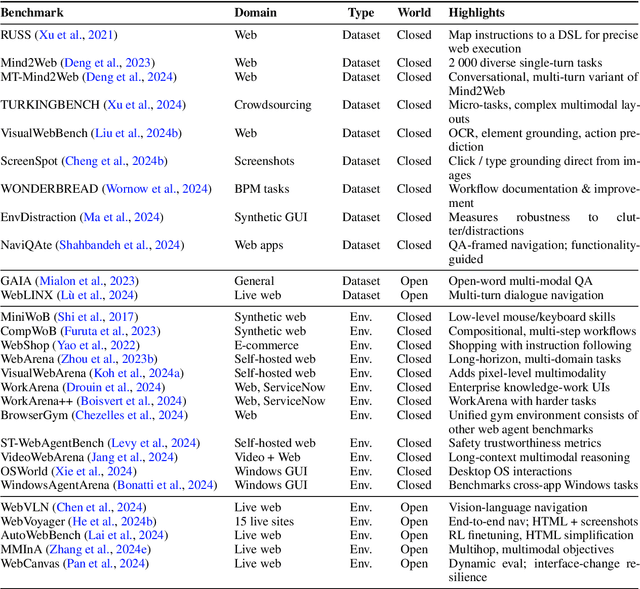
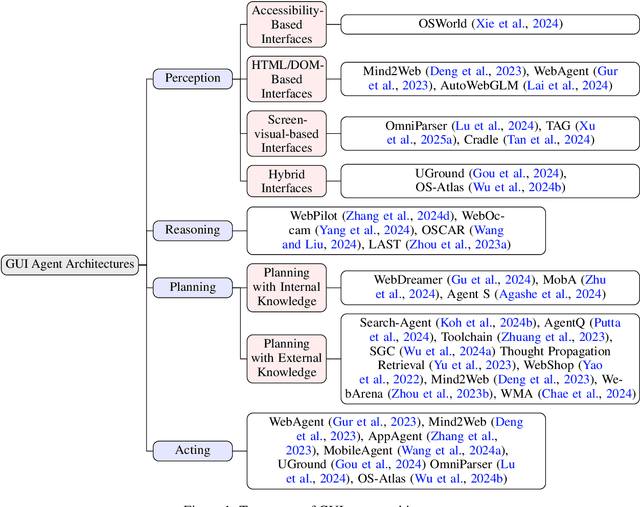

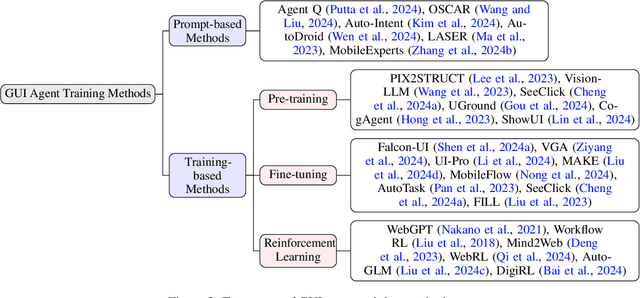
Abstract:Graphical User Interface (GUI) agents, powered by Large Foundation Models, have emerged as a transformative approach to automating human-computer interaction. These agents autonomously interact with digital systems or software applications via GUIs, emulating human actions such as clicking, typing, and navigating visual elements across diverse platforms. Motivated by the growing interest and fundamental importance of GUI agents, we provide a comprehensive survey that categorizes their benchmarks, evaluation metrics, architectures, and training methods. We propose a unified framework that delineates their perception, reasoning, planning, and acting capabilities. Furthermore, we identify important open challenges and discuss key future directions. Finally, this work serves as a basis for practitioners and researchers to gain an intuitive understanding of current progress, techniques, benchmarks, and critical open problems that remain to be addressed.
Futga: Towards Fine-grained Music Understanding through Temporally-enhanced Generative Augmentation
Jul 29, 2024



Abstract:Existing music captioning methods are limited to generating concise global descriptions of short music clips, which fail to capture fine-grained musical characteristics and time-aware musical changes. To address these limitations, we propose FUTGA, a model equipped with fined-grained music understanding capabilities through learning from generative augmentation with temporal compositions. We leverage existing music caption datasets and large language models (LLMs) to synthesize fine-grained music captions with structural descriptions and time boundaries for full-length songs. Augmented by the proposed synthetic dataset, FUTGA is enabled to identify the music's temporal changes at key transition points and their musical functions, as well as generate detailed descriptions for each music segment. We further introduce a full-length music caption dataset generated by FUTGA, as the augmentation of the MusicCaps and the Song Describer datasets. We evaluate the automatically generated captions on several downstream tasks, including music generation and retrieval. The experiments demonstrate the quality of the generated captions and the better performance in various downstream tasks achieved by the proposed music captioning approach. Our code and datasets can be found in \href{https://huggingface.co/JoshuaW1997/FUTGA}{\textcolor{blue}{https://huggingface.co/JoshuaW1997/FUTGA}}.
Mitigating Hallucination in Fictional Character Role-Play
Jun 25, 2024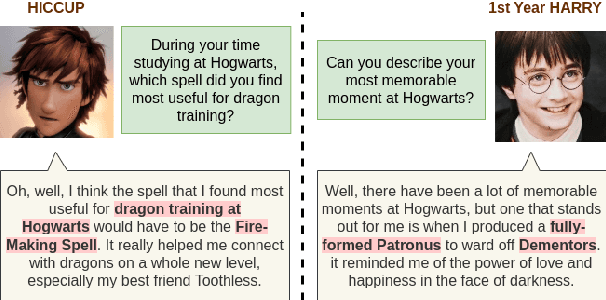

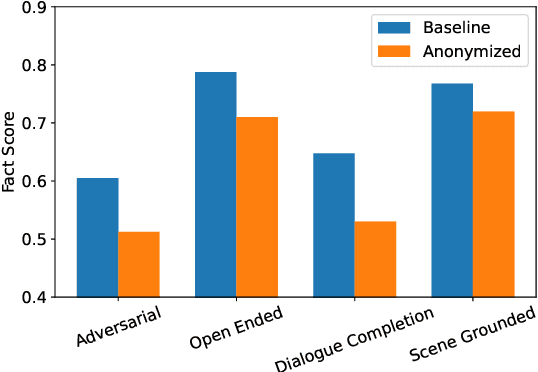
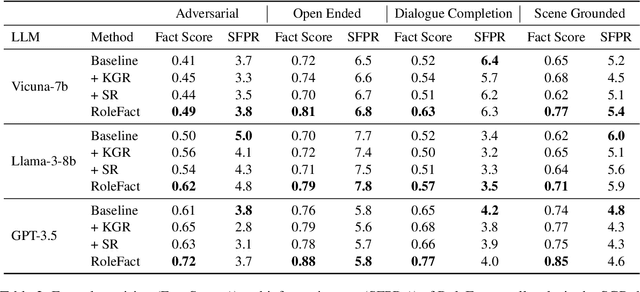
Abstract:Role-playing has wide-ranging applications in customer support, embodied agents, computational social science, etc. The influence of parametric world knowledge of large language models (LLMs) often causes role-playing characters to act out of character and hallucinate about things outside the scope of their knowledge. In this work, we focus on the evaluation and mitigation of hallucination in fictional character role-play. We introduce a dataset with more than 2,000 characters and 72,000 interviews, including 18,000 adversarial questions. We propose RoleFact, a role-playing method that mitigates hallucination by modulating the influence of parametric knowledge using a pre-calibrated confidence threshold. Experiments show that the proposed method improves the factual precision of generated responses by 18% for adversarial questions with a 44% reduction in temporal hallucination for time-sensitive interviews. The code and the dataset will be available at https://github.com/NafisSadeq/rolefact.git.
Reindex-Then-Adapt: Improving Large Language Models for Conversational Recommendation
May 20, 2024Abstract:Large language models (LLMs) are revolutionizing conversational recommender systems by adeptly indexing item content, understanding complex conversational contexts, and generating relevant item titles. However, controlling the distribution of recommended items remains a challenge. This leads to suboptimal performance due to the failure to capture rapidly changing data distributions, such as item popularity, on targeted conversational recommendation platforms. In conversational recommendation, LLMs recommend items by generating the titles (as multiple tokens) autoregressively, making it difficult to obtain and control the recommendations over all items. Thus, we propose a Reindex-Then-Adapt (RTA) framework, which converts multi-token item titles into single tokens within LLMs, and then adjusts the probability distributions over these single-token item titles accordingly. The RTA framework marries the benefits of both LLMs and traditional recommender systems (RecSys): understanding complex queries as LLMs do; while efficiently controlling the recommended item distributions in conversational recommendations as traditional RecSys do. Our framework demonstrates improved accuracy metrics across three different conversational recommendation datasets and two adaptation settings
 Add to Chrome
Add to Chrome Add to Firefox
Add to Firefox Add to Edge
Add to Edge